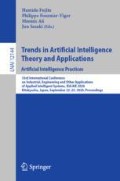Abstract
With the widespread use of mobile devices and GPS, trajectory data mining has become a very popular research field. However, for many applications, a huge amount of trajectory data is collected, which raises the problem of how to efficiently mine this data. To process large batches of trajectory data, this paper proposes a distributed trajectory clustering algorithm based on density peak clustering, named DTR-DPC. The proposed method partitions the trajectory data into dense and sparse areas during the trajectory partitioning and division stage, and then applies different trajectory division methods for different areas. Then, the algorithm replaces each dense area by a single abstract trajectory to fit the distribution of trajectory points in dense areas, which can reduce the amount of distance calculation. Finally, a novel density peak clustering-based method (E-DPC) for Spark is applied, which requires limited human intervention. Experimental results on several large trajectory datasets show that thanks to the proposed approach, runtime of trajectory clustering can be greatly decreased while obtaining a high accuracy.
Access this chapter
Tax calculation will be finalised at checkout
Purchases are for personal use only
References
Lee, J.G., Han, J.: Trajectory clustering: a partition-and-group framework. In: Proceedings of ACM SIGMOD international conference on Management of data, pp. 593–604 (2007)
Wang, Y., Lei, P.: Using DTW to measure trajectory distance in grid space. In: IEEE International Conference on Information Science and Technology, pp. 152–155 (2014)
Lindahl, E., Hess, B., van der Spoel, D.: GROMACS 3.0: a package for molecular simulation and trajectory analysis. J. Mol. Model. 7, 306–317 (2001). https://doi.org/10.1007/s008940100045
Huey-Ru, W., Yeh, M.-Y.: Profiling moving objects by dividing and clustering trajectories spatiotemporally. IEEE Trans. Knowl. Data Eng. 25(11), 2615–2628 (2013)
Li, X., Ceikute, V.: Effective online group discovery in trajectory databases. IEEE Trans. Knowl. Data Eng. 25(11), 2752–2766 (2013)
Rodriguez, A., Laio, A.: Clustering by fast search and find of density peaks. Science 344(6191), 1492 (2014)
Zheng, K., Zheng, Y.: On discovery of gathering patterns from trajectories. In: IEEE International Conference on Data Engineering, pp. 242–253 (2013)
Pei, J., Han, J.: Mining sequential patterns by pattern-growth: the prefixSpan approach. IEEE Trans. Knowl. Data Eng. 16(11), 1424–1440 (2004)
Lin, T.H., Yeh, J.S.: New data structure and algorithm for mining dynamic periodic patterns. In: IET International Conference on Frontier Computing. Theory, Technologies and Applications, pp. 55–59 (2010)
Zheng, K., Zheng, Y.: Online discovery of gathering patterns over trajectories. IEEE Trans. Knowl. Data Eng. 26(8), 1974–1988 (2014)
Boubezoul, A., Koita, A.: Vehicle trajectories classification using support vectors machines for failure trajectory prediction. In: International Conference on Advances in Computational Tools for Engineering Applications, pp. 486–491 (2009)
Choong, M.Y., Angeline, L.: Modeling of vehicle trajectory using k-means and fuzzy c-means clustering. In: IEEE International Conference on Artificial Intelligence in Engineering and Technology, pp. 1–6 (2018)
Anjum, N., Cavallaro, A.: Unsuoervised fuzzy clustering for trjectory analysis. IEEE Int. Conf. Image Process. 3, 213–216 (2007)
Zhao, L., Shi, G.: An adaptive hierarchical clustering method for ship trajectory data based on DBSCAN algorithm. In: IEEE International Conference on Big Data Analysis, pp. 329–336 (2017)
Ailin, H., Zhong, L.: Movement pattern extraction based on a non-parameter clustering algorithm. In: IEEE 4th International Conference on Big Data Analytics, pp. 5–9 (2019)
Wang, N., Gao, S.: Research on fast and parallel clustering method for trajectory data. In: IEEE International Conference on Parallel and Distributed Systems. pp. 252–258 (2018)
Hu, C., Kang, X.: Parallel clustering of big data of spatio-temporal trajectory. In: International Conference on Natural Computation, pp. 769–774 (2015)
Miyamoto, S., Matsumoto, T.: Dynamic distributed genetic algorithm using hierarchical clustering for flight trajectory optimization of winged rocket. In: International Conference on Machine Leraning and Applications, pp. 295–298 (2013)
Chen, Z., Guo, J.: DBSCAN algorithm clustering for massive AIS data based on the hadoop platform. In: International Conference on Industrial Informatics - Computing Technology, Intelligent Technology, Industrial Information Integration, pp. 25–28 (2017)
Wang, N., Gao, S.: Research on fast and paraller clustering method for trajectory data. In: IEEE International Conference on Parallel and Distributed Systems, pp. 252–258 (2018)
Davies, D.L., Bouldin, D.W.: A cluster seperation measure. IEEE Trans. Pattern Anal. Mach. Intell. 1(2), 224–227 (1979)
Acknowledgments
This research is sponsored by the Scientific Research Project of State Grid Sichuan Electric Power Company Information and Communication Company under Grant No. SGSCXT00XGJS1800219, and the Joint Funds of the Ministry of Education of China.
Author information
Authors and Affiliations
Corresponding author
Editor information
Editors and Affiliations
Rights and permissions
Copyright information
© 2020 Springer Nature Switzerland AG
About this paper
Cite this paper
Zheng, Y., Niu, X., Fournier-Viger, P., Li, F., Gao, L. (2020). Distributed Density Peak Clustering of Trajectory Data on Spark. In: Fujita, H., Fournier-Viger, P., Ali, M., Sasaki, J. (eds) Trends in Artificial Intelligence Theory and Applications. Artificial Intelligence Practices. IEA/AIE 2020. Lecture Notes in Computer Science(), vol 12144. Springer, Cham. https://doi.org/10.1007/978-3-030-55789-8_68
Download citation
DOI: https://doi.org/10.1007/978-3-030-55789-8_68
Published:
Publisher Name: Springer, Cham
Print ISBN: 978-3-030-55788-1
Online ISBN: 978-3-030-55789-8
eBook Packages: Computer ScienceComputer Science (R0)

